Hip Joint Mechanics Analysis
 Oct. 29, 2020
Oct. 29, 2020
The hip joint is the largest and most stable club and socket joint in the human body. Under normal circumstances, the hip joint can safely transmit loads and move flexibly. Today joint prosthesis manufacturer will introduce to you the mechanical analysis of the hip joint.
1. When standing on both feet
Center of gravity and hip joint contact force
When standing still with both feet, the hip joints support the head, torso, and upper limbs, and bear about 62% of the body weight. At this time, the center of gravity is located on the mid-sagittal plane and the horizontal plane of the T10 and 11 intervertebral discs, and the vertical line of the center of gravity just intersects at the midpoint of the line of rotation centers of the bilateral femoral heads.
If the hip support is symmetrical, then each hip joint bears 31% of the body weight. Taking a weight of 60kg as an example, the two sides bear a total of 37.2kg and each side bears 18.6kg. If the weight-bearing area of each femoral head is 12c㎡, the femoral head bears a force of 1.55kg per square centimeter.
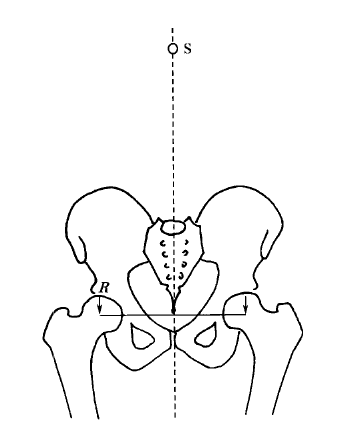
The center of gravity (S) and the force acting on one hip joint (R) when both feet standstill and symmetrically
2. When standing on one foot
Center of gravity and hip joint contact force
When standing still on one foot, the load-bearing hip joint supports the head, trunk, bilateral upper limbs, and contralateral lower limbs, and approximately 81% of the body weight. At this time, the center of gravity moves down to the plane of the intervertebral disc between L3 and L4 on the horizontal plane, and moves 2.5cm to the weight-bearing side on the coronal plane, and is located in the sagittal plane near the coronal plane of the rotation center of the hip joint on the bearing side.
Standing on one foot makes the hip joint on the load side eccentrically stressed and the pelvis tilts. In order to keep the hip joint stable, the abductor force M must be balanced. The moment arm of force K is about 3 times that of the M moment arm, so the resultant force R is about 3 times more than the total weight. The force line of the resultant force R intersects the force line of the force K and M at a point and passes through the center of the femoral head. The inclination angle of the line of force of the normal hip joint R relative to the vertical line of the ground is about 16°.
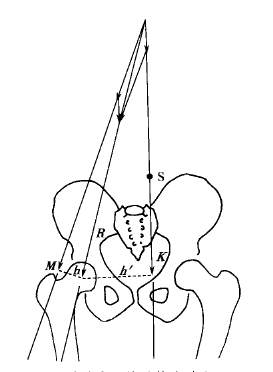
S is the center of gravity; K is the vertical force of the body weight; h is the moment arm of K; M is the abductor muscle strength; h is the moment arm of M; R is the combined force of K and M
3. Stress distribution of normal femoral neck
The force line of the resultant force R is inconsistent with the axis of the femoral neck. After R intersects the center of the femoral head, it extends distally and deviates from the axis of the femoral neck downwardly and inwardly, resulting in compressive and tensile stresses in the femoral neck, and the compressive stress is always Greater than tensile stress. The maximum compressive stress is located at the medial edge of the femur. The closer to the central axis of the femoral neck, the smaller the compressive and tensile stresses. The central axis of the femoral neck is O. The resultant force R acts on the femoral neck obliquely, producing a shear force S. The size of S depends on the inclination angle of the resultant force R and the axis of the femoral neck.
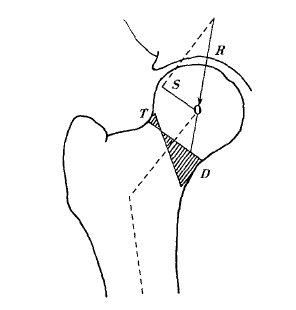
D is compressive stress; T is tensile stress; S is shear stress.
4. Changes in geometry
Impact on hip joint strength
Changes in joint anatomy caused by surgery or disease can lead to changes in the contact surface and contact force, thereby affecting the mechanical condition of the hip joint. Changes in joint geometry affect muscle strength and the ability to generate torque.
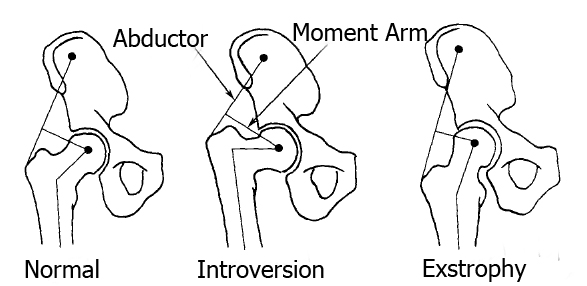
In a total hip replacement, the arm of weight can be shortened by deepening the acetabulum (centralization of the femoral head), and the arm of the abductor's muscle can be lengthened by moving the greater tuberosity outward, thereby reducing the arm of weight generated by the body. The corresponding balance force produced by the abductor's muscles is also reduced.
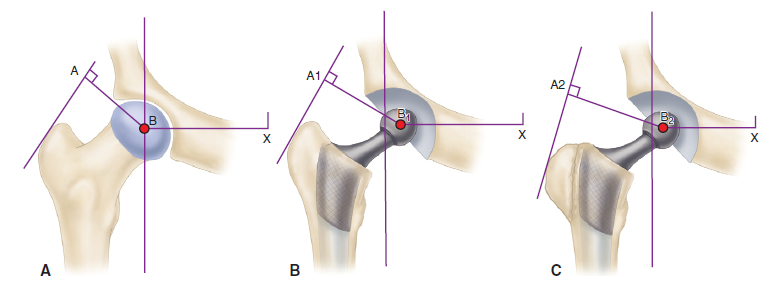
A is normal; B is the centralization of the femoral head; C greater tuberosity shifted laterally and distally.
Our company provides primary hip prosthesis.













